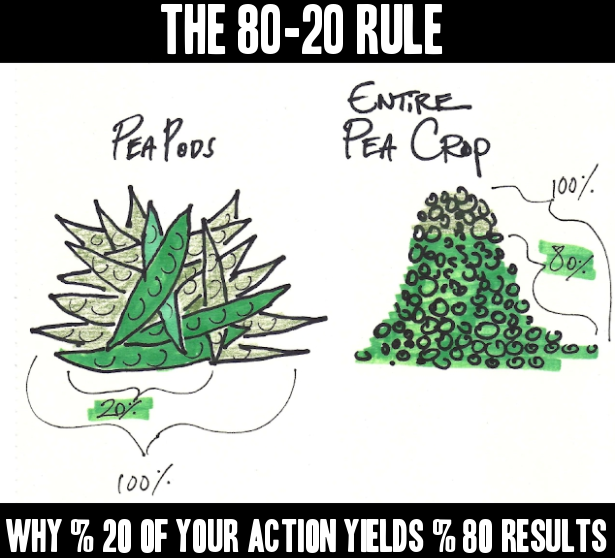
Today, I want to review a basic mental heuristic that I learned in college but has helped me immensely me ever since. Sometimes this mental shortcut is referred to simply as the 80-20 rule, but is more formally known as “Pareto’s Principle”.
Simply put, Pareto’s Principle states that, for many events, roughly %80 of the effects come from %20 of causes.
Pareto’s Principle
The original study that Vilfredo Pareto conducted was in Italy, 1906. The study began with a strange observation in Pareto’s garden, where he found that %20 of the peapods in his garden contributed to %80 of the peas. He then decided to take this one step further and had observed an astonishing statistical measure where %80 of land in Italy was owned by only %20 of the people. This sort of distribution was not ‘normal‘ at all but was really quite freakish.
Pareto went on to study the distributions of wealth amongst society.
Pareto gathered data regarding income and wealth from Switzerland, Germany, Britain, Prussia, Saxony, Ireland, Italy, and Peru. What he found was striking – society was not a “social pyramid” with gradual differences between the richest and poorest in society. He found that there was a huge mass of people on the bottom of the wealth chart and a very thin sliver of individuals with most of the money at the top. Needless to say, his findings were incredibly disheartening. He found that inequality in income and wealth was drastic and only getting worse – and this was in 1906.
Furthermore, Pareto even went to the extreme lengths of claiming that “Democracy is a fraud“.
Pareto spent the rest of his life trying to right this wrong. He opened the “Laussane School” in order to help the impoverished youths of his country and published numerous books and statistical concepts that are still used today.
For me, Pareto was ahead of his time. He ended up bumping heads with the Italian government for telling such tales of inequality and was deemed a fascist. Today, we see more clearly than ever that Vilfredo Pareto’s analysis of the disparities in wealth was right – with more than %50 of the wealth being held by %1 of the individuals at the top.
Examples of the 80/20 Rule
Besides the dreary conclusions about inequality in wealth and income – the 80-20 rule is useful in determining many other phenomenon in life. Below are several real-life examples that you may relate to:
Why %20 of the people in a group project do %80 of the work
Why %20 of the employees at a company are responsible for %80 of the growth
Why %20 of the customers generate %80 of the sales
Why %20 of products in a store generate %80 of the sales
Why %20 of the population controls %80 of government policy
Why %20 of software bugs cause %80 of the issues raised
Why %80 of complaints come from %20 of the customers
Why %20 of your teachers/professors teach you %80 of the things you know
Why we complete %80 of our work in %20 of the day
Why %80 of healthcare is used by %20 of the patients
Why %20 of your activities will account for %80 of your results
That last one is the most compelling one to me. Understanding that a %20 change in your action will yield a %80 change in your results in life. These examples might not be completely relatable to you in your specific situation, but try your best to see how you can apply this mental heuristic to your own life.
For me, Pareto’s Principle has been absolutely key in shaping my mindset today.
Why It’s Useful
Once you understand that the 80-20 rule is an abnormal distribution of desired results, you will begin to understand how you can leverage this principle for your own selfish needs.
In terms of increasing your income: If you are working on a team of 20 people, then it will be critical that you differentiate yourself from the group by being the top performing %20 of people – the top 4 people. Being average just won’t cut it in life. Once you have established yourself as a high performer (in the top %20), you will stand out from the crowd and be first in line for promotions, raises, and opportunities.
In terms of cutting your expenses and increasing savings: If you take the time to track your budget and expenses, you will begin to see that most of your disposable income (after taxes/housing/transportation) goes to the same 2-3 categories. Those 2-3 categories might be food, clothes, child-care, vacations, lifestyle choices, healthcare costs, music festivals, and other vices – like drugs, weed, or alcohol.
For me, %80 of my disposable income is spent on savings, food, and technology/video games.
In terms of income, wealth, and investing: If you invest intelligently and spread your net worth across several asset types, you will find that %80 of your gains/losses come from %20 of your assets. Maybe you made (or lost) a huge sum of money while investing in Bitcoin. Or maybe you realize that more than %80 of your wealth comes from less than %20 of your activities – like your job.
I know in my personal investment portfolio, more than half of my overall gains came from two of my best stock picks – Nvidia ($NVDA) & Twitter ($TWTR).
—
So, figure out how you can leverage “The 80-20 Rule” (Pareto’s Principle) to work for your specific situation in life. You only need to focus on %20 of your life to get a %80 change.
And as always, if you found this article helpful, insightful, or the least bit interesting, then don’t forget to like, comment, subscribe, follow, and SHARE!
Thanks for reading.
-Jack
P.S. The above is meant to be for general education purposes only and not investing advice as I am not aware of your specific situation or risk tolerance.